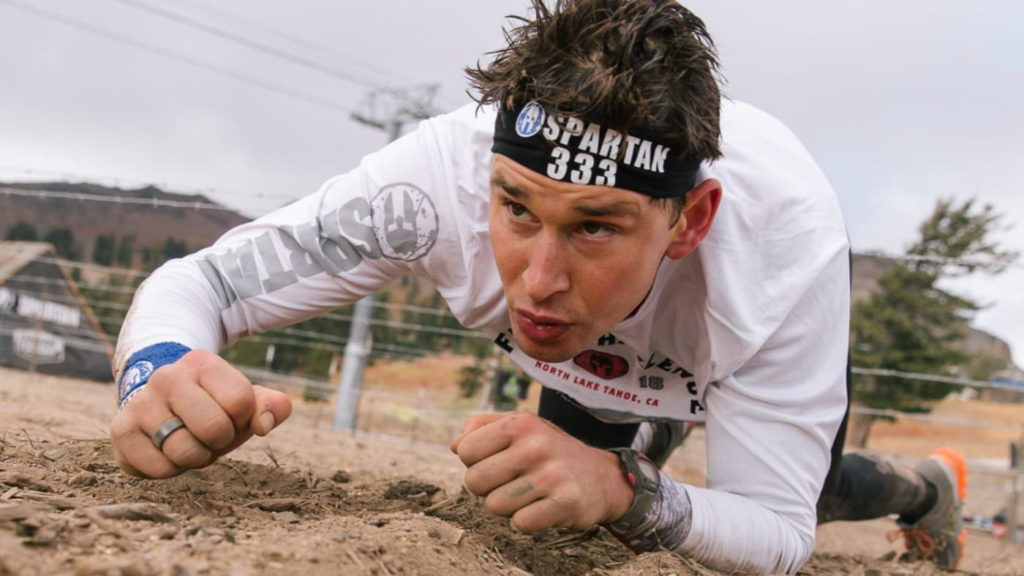November 28, 2016
During my last 32 mile obstacle race in Lake Tahoe at the Spartan World Championships, I sprained my ankle.
We're not talking a slight twist. We're talking a full blown, golf ball sized chunk of swelling on the inner side of my foot.
And sure, I did things like inject BPC-157 peptides into my ankle, along with plenty of the other physical therapy modalities I recently discussed in my podcast with John Rusin entitled “7 Cutting-Edge Physical Therapy & Recovery Techniques You Can Use To Heal Your Body Fast“…
…but it's one thing to heal your ankle and quite another to actually bulletproof your ankle against future injuries and sprains. In this article, written by my personal obstacle course racing and Spartan coach Yancy Culp, you're going to discover exactly how to not only build an unbreakable ankle, but you'll also learn a potent technique to run faster.
Enjoy (and click here if you want to learn more about Yancy Culp and his coaching programs).
There’s plenty of talk and plenty of research on the importance of midfoot strike when it comes to improving running efficiency. In the video above and in this article I’m going to shed some light on the importance of finding your midfoot strike for reducing ankle sprains. In the sport of Obstacle Course Racing (OCR), trail running, and fell running, ankle sprains are a common injury that occur during both training and racing – and frankly, weekend warriors and the average exercise enthusiast frequently suffer from these frustrating lower leg setbacks as well.
Let’s walk through the video above and expand on the information I provide, shall we?
In this video, I’m on a technical single track trail in Austin, Texas – where you’ll find rocks, roots, branches, drop-offs, and other variables that cause undulating movement. This is a very typical situation in an OCR or trail running event. Many races take place in areas where course designers randomly mark courses that take you through pastures, rolling hills, and mountains where certain sections aren’t on existing trails and you find yourself running through ankle or even knee deep grass.
In all such trail and off trail situations, there are literally thousands of ankle spraining obstacles you'll be forced to navigate through during your race or training run.
Not to mention the crucial importance of ankle strength for your posture, for squats, for deadlifts, for your lunchtime run, and beyond.
During a race or training run, your neuromuscular system must make thousands of split second decisions about where to your feet should make contact with the ground. While on the trail, these decisions can be very meticulous because you can see where the foot will hit.
But while running through the grassy areas that I describe in the video above, you can’t see exactly what the foot is going to make contact with. This makes something called a “midfoot ground contact” extremely important. In the video above, I discuss the anatomy of the ankle and foot: at the ankle joint, you have the tibia and fibula sitting on top of the talus bone. The joint's planes of motion are dorsiflexion (foot rises and toes point toward your shin), plantarflexion (foot points away from you – as if you’re “planting” it in the ground), inversion (supination), and eversion (pronation). In the foot you have 26 bones, 33 joints, and more than a 100 ligaments, muscles, and tendons.
Now let’s go in to greater detail on why you can dramatically reduce the risk of ankle sprains when you consistently find your midfoot strike while running vs heel striking.
As you see in the video above, I demonstrate the few things that can happen when you strike an object or uneven terrain with a heel strike. In many cases, your ankle is going to roll in the inversion or eversion plane and can cause a sprain. When you strike the ground with your midfoot, you’re making ground contact with a surface than can quickly adapt and mold around the object and uneven terrain because of the many joints that make up the foot.
When the midfoot strikes first, there isn’t as much movement at the tibia, fibula, and talus joints. This can prevent ankle sprain injuries while you’re out on trails, and when you’re in the uneven grassy areas it becomes even more beneficial at preventing injuries because you’re allowing your highly mobile and flexible foot joints to quickly adapt to the issue you couldn’t see as your foot was plunging down through the grass.
You’ll find that many top level, efficient and pleasant-to-watch runners are midfoot strikers and many runners not in the top level category are slightly more biomechanically ugly heel strikers. With practice, you’ll find yourself being able to find your midfoot on flats and on most downhills.
Now let’s discuss a few of the running efficiency benefits you gain by midfoot striking vs heel striking.
When you midfoot strike, your foot is making contact under your center of gravity. For most, when they heel strike, the leg/foot is overstriding and making contact with the ground out in front of the center of gravity. This creates a brief moment where you’re interrupting the smooth leg turnover and creating a braking action at the ground that sends more shock and impact up through the body and joints, and this can lead to various injuries that are common with runners, like knee pain, hip pain, and lower back pain. By midfoot striking, you erase the overstride that cause the breaking action and you reduce the amount of shock that occurs during ground contact.
The midfoot strike will also reduce vertical oscillation. Vertical oscillation is the up and down movement that occurs when you run. Let’s look at this in greater detail.
A three hour marathon for a 180 cadence runner equals appx 32,400 ground contacts…
…so a runner with a 5” (13 centimers) vertical oscillation (2.5” up and 2.5” down) will total 162,000” or 13,500’ of up and down motion during a marathon…
…but reducing this vertical oscillation to 2” (5 centimeters) brings this same runner down to 64,800” or 5,400” of up and down motion!
You can start to quickly see the dramatic difference it can make on reducing the amount of shock your body takes on with the lower vertical oscillation number, reducing unnecessary up and down motion, and lowering your energy burn. By midfoot striking you’re also reducing ground contact time.
In summary, ankle sprains are a common injury during OCR events, trail running, and fell running. Working on finding your midfoot strike can reduce your risk of ankle sprains while also improving the entire kinetic chain of movement while running – and even if you don't ever plan on obstacle racing, it will help you walk and move more efficiently, have better posture and avoid those frustrating twists and sprains that can lead to you being unable to play the sports and do the activities you desire.
Finally, I’ve been running competitively for 30+ years. I’ve never been sidelined with an injury, but this doesn’t come without the help and education from others. I’ve learned a lot over the years and I want to give a shout out to running coach Richard Diaz who I consider an industry expert when it comes to running gait analysis and quickly helping runners hone their running efficiency. Attending one of his traveling running clinics or getting out to a session at his home base in California can go a long way at helping you become a more efficient runner while also reducing injuries. Click here to learn more about Richard.
Summary
Want more of Yancy Culp?
Check out his previous Ben Greenfield Fitness video and article “Get A Grip: Why Grip Strength Is So Darn Important And 7 Potent Ways To Increase Your Grip Strength“…
…and, as a thank you for being a loyal blog reader, I'm also giving you a free month of coaching with Yancy Culp if you click here. Yep, that's right. You can get access to the identical workouts I personally do each week to prepare for Spartan racing, general fitness, grip strength, running speed, looking good naked and beyond. Enjoy. (*limited time offer)
Do you have questions, thoughts or feedback for Yancy or me? Leave your comments below and one of us will reply!














Thank you for the great video and I agree that the midfoot will conform to small objects and adjust accordingly. No it won’t mold itself perfectly to all objects but it doesn’t have to in order to keep the ankle from turning. But you can pretty much throw all that to the wayside if you’re running in rigid, thick soled, motion controlled, arch supported, high heel, high drop, narrow tow boxed, shoes. The typical modern day running shoe promotes heel striking, over striding and hard pounding and has caused more foot problems than all other reasons put together. It’s basically like wearing a cast on your feet which leaves your foot muscles in a state of atrophy. There’s no sensory input going to the brain because the thick soles block it out. I’ve been plagued with foot, ankle, knee, hip, and back pain for the last 20 years but it wasn’t until I discovered barefoot running/walking that my pains disappeared and my feet and ankles are stronger than ever. I now road run barefoot and trail run in minimalist sandals pain free. It’s literally changed my life.
For me – the single best thing I’ve done is implement high weight calf-raises with toes turned inward & outward as well as straight ahead. It may be a fallacy, but it’s my belief that large calf muscles help in strengthening the supporting muscles in my feet as well – even though I’ve no idea what they’re called.
Also, kinesthetic awareness is also helpful – so I drink more than just a cup of coffee in the morning.
Hi Ben,
I run mid foot and find a lot of advantages running this way. Nevertheless the explanation saying the foot will conforme to a rock thx to its structure is false. A non active foot can do it, but an active foot is very rigid (almost like thin wood) and the deformation is a matter of millimeters not enough to adapt its form to a rock. That being said I also think running mid foot decreases the risk ankle sprain but not for the reason illustrated in the video. I could develop it if needed.
And thx for all your great work.
Best regards
Jean-Charles
PhD in biomechanics